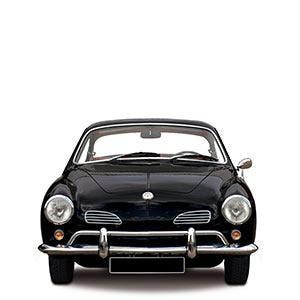Porsche 911 RS: Rennsport Model History
You know the badges, the countless tribute builds, and are fully aware of their position at the top of the Zuffenhaus tree. But to produce a more detailed guide to these halo cars, we called up a friend who studied these facts and figures for so long that he crafted a career sharing his knowledge with fellow Porsche enthusiasts.
Allow Lee Sibley from 9WERKS to give you the low down on these very special sportscars... He takes us through every 'classic' Rennsport 911 model from the past 40 years.
What does Rennsport mean?
It’s crazy to think that Porsche wasn’t convinced of the marketability of its 911 ‘Rennsport’ concept, just before the release of that fabled 2.7 RS in 1972. The company thought it might struggle to sell the required 500 to homologate the RSR race car on which it is based… history tells us how very wrong those marketing bods were because 50 years on, ‘RS’ is now one of the most fabled monikers in Porschedom.
‘Rennsport’, or ‘race sport’, is the model designation given to Porsche sports cars which homologate their race car brothers for use in international GT racing. That is, these RSs are the road-legal versions of the mighty RSR, which has contributed significantly to more than 30,000 race victories enjoyed by the 911 over the years.
The RS is the most performance-oriented car in the 911 line-up, completely uncompromising in its quest for ultimate performance. Their high revving, emotive engines, mixed with a race-ready chassis, cutting-edge aero and lightweight application means these are coveted sports cars, lusted after by many. Only a few can afford them, and even fewer still are lucky to get their hands on them, as the build numbers tend to be incredibly low.


2.7 Carrera RS
Years produced: 1972-73
Numbers made: 1,592
Why it’s special: The 2.7 is RS Genesis. Introduced in 1973 and badged ‘Carrera RS’, Porsche’s first 911 to get the Rennsport treatment was given significant upgrades over the 911S. For starters, it enjoyed an increase in engine size from 2.4-litres to 2.7-litres, with a power hike to boot from 190bhp to 210bhp.
Most notably, the 2.7 Carrera RS was the first road car to use a rear wing: its ‘burzel’ or ‘ducktail’ spoiler helping to reduce lift at the back of the 911 during high speeds. A revised front bumper managed airflow at the car’s nose, while also housing an additional oil cooler.
The 2.7 Carrera RS was available in two trims: Touring and Lightweight specification. The Touring weighed in at 1,075kg while the Lightweight tipped the scales at 975kg thanks to its reduction in sound deadening, use of plexiglass for all except the windscreen, and lightweight bumpers.
Many of these cars were used for club racing and rallies over the years, before enjoying a significant upturn in values around 15 years ago. Today, you’ll pay in excess of half a million pounds for a Touring, while a Lightweight with serious provenance will cost you a seven-figure sum.
This RS model is easily the most copied. Get the look by read our guide here on how to backdate your Porsche 911.


3.0 Carrera RS
Years produced: 1974
Numbers made: 145
Why it’s special: The next RS arrived only one model year later, though it was much changed over the first. Engine capacity was enlarged to 3.0-litres and power up to 230bhp, while the chassis benefitted from the 911’s changeover from F-series to G-series incorporating a wider body with steel arches front and rear, which on the RS were added by hand. Brakes were carried over from the halo 917 race car, so stopping power was mightier and more efficient too, while thicker anti-roll bars delivered improved handling. Aesthetically, the 3.0 RS looked very different to its predecessor: on top of the aforementioned change from ‘long bonnet’ to ‘impact bumper’, the 3.0 RS is distinguishable by its Turbo-style ‘whale tail’ rear wing, rather than the 2.7 RS’s dainty ducktail. Inside, the large 4-spoke wheel of the F-series was ditched for a smaller-diameter three-spoke wheel, among other interior changes, though the spartan Rennsport recipe was still very much evident.
While the 2.7 RS is considered a must for any collector, the 3.0 RS is often overlooked, simply because many (except from true connoisseurs) know of its existence. To our mind, it’s a real gem of an RS and one of the best classic 911s you can hope to drive.


SC RS
Years produced: 1982-85
Numbers made: 21
Why it’s special: The SC RS is unique in this list as it’s the only 911 Rennsport which never saw the public road. Instead, this was a purely competition-focussed RS designed for Porsche customer teams to compete in Group B rallying. The SC RS saw relative success, finishing third in the 1982 Monte Carlo rally and 1985 Tour de Corse. Today the cars are tucked up in the collections of rally enthusiasts.
Its specification includes a 255bhp, 3.0-litre flat six. The car weighed only 940kg, an incredible feat given the chassis strengthening and additional spec required for rallying. Visually the SC RS rides much higher than any other 911 RS on longer travel suspension and features mud guards aft of each wheel. Sticky road rubber was replaced with baulky off-road tyres depending on the stage setting. Six of the 21 cars were resplendent in iconic Rothmans livery, featuring a fibreglass front lid and wings. The SC RS was also known for being notoriously loud. Again, due to its rarity and the fact it was a competition-only model, many are unaware the SC RS even exists!


964 Carrera RS
Years produced: 1992-93
Numbers made: 2,405
Why it’s special: The Porsche 964 hailed a return of the Carrera RS moniker after a near-20-year hiatus. On paper, it wasn’t too dissimilar from its Carrera sister: just a 10bhp upgrade from 250 to 260 bhp, though a weight saving of 120kg was more like the RS of old. However, and as is usual with Porsche, the sum of its parts was much more: a focussed chassis with razor-sharp throttle response (thanks to a single mass flywheel), plus a seam-welded chassis, delivered a car which was quick off the mark and purposeful in the corners.
A 964 Carrera RS holds high appeal among collectors today, but refreshingly, many owners have used the 964 RS as inspiration for their own Carrera-based home build. This is relatively straightforward to accomplish as the RS shared the same narrow body, in principle, as the Carrera, and had a fairly similar look too, with its active rear wing, Cup wheels, reduced ride height, and brake cooling ducts in the front bumper. It’s half the reason a non-sunroof, rear-wheel drive and manual 964 Carrera 2 is sought-after among enthusiasts today, as these cars are a great basis on which to replicate the halo RS model.
Later, Porsche produced some 55 964 Carrera RS in 3.8-litre specification. These cars were wide-bodied, and featured Turbo brakes and Speedline wheels, as well as a huge, bi-planed, fixed rear wing.




993 Carrera RS
Years produced: 1995-96
Numbers made: 1,014
Why it’s special: The last air-cooled RS (and the last time ‘Carrera’ would be used in its title) was a special 911, wrapping up more than two decades of Rennsport development. The flat-six out back was 3.8-litres (the standard Carrera was 3.6) and introduced a ‘VarioRam’ variable-length intake system into the 911 specification for the first time. Its 300hp engine with twin exit exhausts was bolted to a 6-speed gearbox with crisp short shift, plus a single-mass flywheel.
Unlike the 964 Carrera RS, the 993 Carrera RS used a wider body with greater consideration for manipulation of air around the car. A new front lip with an upturned side profile is an example of this, while side lights were removed in favour of additional air inlets to feed cold air to the brakes. Meanwhile, at the back, Touring versions got a fixed, modern whale tale-esque wing (devoid of rubber lips for the first time) while the lightweight Clubsport got a bi-planed fixed wing. The 993 RS was much stiffer, and offered excellent, direct handling, while the smaller three-spoke ‘RS’ steering wheel is considered one of the best to hold. The 993 Carrera RS is a real delight and a fitting finale for the classic 911 Rennsport.


996 GT3 RS
Years produced: 2003-04
Numbers made: 682
Why it’s special: The Porsche 996 was a line-in-the-sand moment for the 911 in general, and the RS was no different. ‘Carrera RS’ became ‘GT3 RS’, as Porsche was now homologating its cars for the FIA’s new GT3 category of racing. A 3.6-litre ‘Mezger’ engine was housed in the back (as it was still dry-sumped), though now it was cooled by water rather than air. The flat-six produced an identical 381bhp to the 996.2 GT3 beneath it, however, the RS’s improved aero and chassis meant the way it went down the road or around a circuit was much improved compared to the GT3.
Inside, the first GT3 RS was comprehensively stripped out, with plexiglass used aft of the b-pillar to keep weight to 1,360kg.
As the first GT3 RS, the 996 today is highly sought after by enthusiasts and collectors. Add in the fact it’s the last narrow-bodied RS, and the last without any electronic traction control, and it’s not hard to see why many tip these cars to appreciate significantly in the coming years.
Unbelievably, the reason there were only 682 examples made is simply that that’s all Porsche could sell at the time – compared to today when demand far outstrips the supply of every new GT3 RS.


997.1 GT3 RS
Years produced: 2006-07
Numbers made: 1,106
Why it’s special: On paper, the first generation 997 GT3 RS offered the same performance as the 997.1 GT3 in terms of power, with the RS weighing in at only 20kg lighter. However, the sum of its parts is far greater, and the 997.1 GT3 RS is an exquisite driving machine. Its chassis is precise, its six-speed manual gearbox with short-shift is one of the best in the business, and the guttural howl from that flat six Mezger will live long in the memory, too. Finished in either RS green or Pure orange, the 997.1, the last narrow-bodied RS featured evocative ‘GT3 RS’ side decals in black, alongside an exposed carbon rear wing.
The 997 interior continued what would become the usual GT3 RS fare; with a colour-coded roll cage, lightweight, single-piece bucket seats (taken from the Carrera GT), plexiglass for the rear windows plus, in some cases, deletion of air conditioning and PCM.
Sitting between the first GT3 RS in the 996, and one of the most revered GT3 Rennsport in the 997.2, the 997.1 is the oft-forgotten RS, which means it’s potentially a great buy if you’re looking for a scintillating 911 which may appreciate in future.


997.2 GT3 RS
Years produced: 2009-11
Numbers made: 1,500
Why it’s special: For the 997.2, Porsche switched to a Turbo-wide body for the first time, though in reality, it was only 44mm wider than the 997.1. Power was increased from 415bhp to 450bhp, thanks largely to an increase in engine capacity from 3.6 litres to 3.8.
The 997.2 GT3 RS was also the first to use the now customary centre-locking wheels, in a direct nod to its motorsport roots. At the same time, dynamic engine mounts and PASM (active suspension management) served as evidence of further technological integration.
Still naturally aspirated and with a six-speed manual, the 997.2 GT3 RS also got a higher fixed rear wing for more downforce, while weight was kept down to just 1,370kg thanks to the removal of sound deadening, the wheel brace, plus deletion of air conditioning if you so wished. Style-wise, the 3.8 RS has the LED front and rear lighting seen elsewhere on the 997.2 generation.


997 GT3 RS 4.0
Years produced: 2011
Numbers made: 600
Why it’s special: The last hurrah for the modern-classic 911, the 997 GT3 RS 4.0 is universally heralded by enthusiasts and collectors alike. As its name suggests, this was the famous Mezger engine – housed in the back of 911 race cars for decades – in its ultimate form, with a cubic capacity of 4.0-litres and a bonkers 125bhp per litre for the first time.
This was a real parts bin special, too, featuring a host of upgrades taken directly from Porsche’s RSR race car. Its lightweight crankshaft was one of them.
Its aero was significantly improved over the 3.8-litre 997 too, with a larger rear wing sitting on taller struts, while at the front, dive planes were deployed at either end of the bumper. All this contributed to a significant increase in downforce.
Rumour has it Porsche made a loss on every single RS 4.0 it made, and as such these cars – built as part of a limited and numbered production run of just 600 – were only offered to very loyal customers with a history of previous Rennsport purchases.
Today these cars are highly sought after, and trade hands at around three times original RRP. With a six-speed manual gearbox, a passive rear axle and hydraulically assisted steering, the RS 4.0 is the ultimate modern classic Rennsport, and is assured of its place at the top table of 911s.


997 GT2 RS
Years produced: 2010
Numbers made: 500
Why it’s special: How about this for something different? In 2010, Porsche applied its Rennsport philosophy to a turbocharged 911 for the first time, giving us the 997 GT2 RS. With a mammoth 620bhp, the GT2 RS enjoyed a significant power hike over the 997 GT2 (which had 530hp), plus it was much lighter too by 70kg at 1,370kg. And don’t forget, the GT2 itself was chiselled from the 997.2 Turbo, highlighting just how much of an engineering feat the first GT2 RS is.
It had a top speed of 205mph, making it the fastest 911 of all time… until its successor in the 991 GT2 RS knocked the 997 off its perch. However, with subsequent RSs switching to PDK, the 997 GT2 RS still holds the crown as the fastest ever manual Porsche 911 – and probably always will.
The first GT2 RS introduced an abundance of carbon fibre displayed all over its intricate bodywork,
To drive, the GT2 RS really is an exquisite melding of delicate, exquisite touch points that we’ve come to know and love with all Rennsports, balanced with brutal turbocharging which gives the 2 RS a whole new level of performance and intrigued compared to its naturally-aspirated 3 RS siblings. With just 500 made, the GT2 RS is also the rarest modern Rennsport, which contributes significantly to the fact many are hidden in collections, rather than driven.


Our thanks to Lee Sibley for sharing his knowledge with us for this article. If you are shopping for a Porsche do check out the 9Werks Marketplace, and tune into the 9Werks Podcast and 9Werks TV for your next Stuttgart-related entertainment fix.
Andy




 Beetle
Beetle
 Karmann Ghia
Karmann Ghia
 Type 2 Split
Type 2 Split
 Type 2 Bay
Type 2 Bay
 Type 25
Type 25
 Transporter T5
Transporter T5
 Golf Mk1
Golf Mk1
 Golf Mk2
Golf Mk2


 911
911
 996
996
 997
997
 986 Boxster
986 Boxster
 987 Boxster
987 Boxster
 912
912
 944
944
 924
924


